
Reviving a selenium meter
A five-step approach to life (for your meter)
You've spent big bucks on your classic camera, only to find the selenium
meter is deader than a doornail. Or is it?
I've found that most selenium meters don't die. They just need a bit of
work to coax them back to life. These instructions apply to many of
the Zeiss Ikon cameras, as their inner workings tend to be easier to open.
Remember, if you proceed, it's on you. And one more thing: This will void
your warranty.
I've performed this surgery roughly a dozen times on the folding Zeiss
Ikon Contessa. In one case, I found a very weak selenium cell, so I had to
replace the cell. In another
instance, someone else had tampered with the camera and desoldered most of
the connections [grrrr!]. With all other cameras, 10 minutes of work has
been enough to make the meter jump back to life.
Doctor, is the patient really dead?
Make a quick check to see if the meter is
sluggish or dead. That shouldn't be
difficult. Simply open the little door and point it toward a bright light. Sorry
about the "Close Encounters of the Third Kind" effect. I was trying to keep
the camera very close to the light source to see if the needle moved even
slightly. It didn't.
This is a camera I bought last
year, and I saw that the meter was dead. I had no way of knowing if it could
be revived, so I hope I don't end up with egg on my face.
|
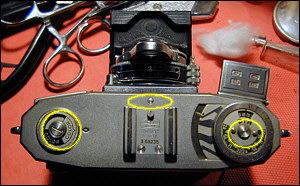
STEP ONE: Remove the three circled
screws. You don't have to remove the accessory shoe, unless you're planning a total restoration. Remove the collar surrounding the calibration
screw. I loosen with a spanner wrench and then remove using my
thumbnail.
|
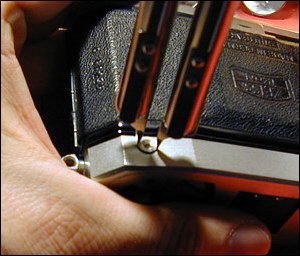 |
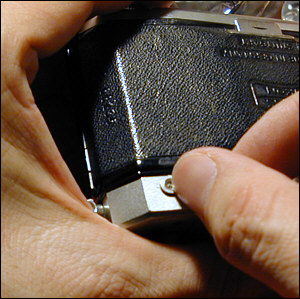 |
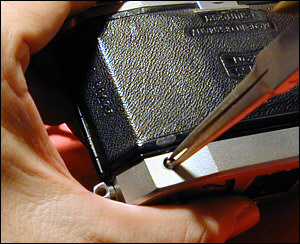
STEP TWO: You might have to use
needle-nose pliers to remove the calibration post, if it doesn't come
out easily. Lift off the cover. You might have to use the always handy
thumbnail to pry up one end at a time. |
|
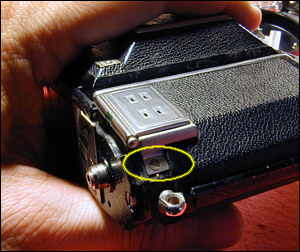 |
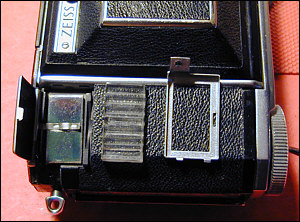
STEP THREE: Remove the screw that
holds on the meter cover (at left). The parts are simply the frame, the
plastic cover and the selenium cell. |
|
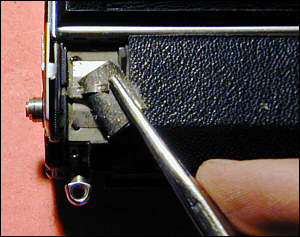
STEP FOUR: Clean all contacts.
Burnish them using
either steel wool or a very light abrasive material. Make sure you blow out any debris |
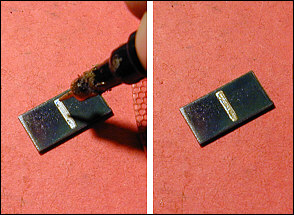
STEP FIVE: This step isn't always
necessary, though I generally do it anyway. Using a small gold or
silver pen, I simply draw a line over the small solder stripe. I've been using
the Pilot brand Silver and Gold Marker. I haven't tried the new gel pens.
Why mess with success? |
|
It lives!
(Damn, I'm good)
Let the marker dry. Slide the selenium cell back into place without
reassembling and point it toward a light. You might need to jiggle
slightly. In most cases, as here, the meter will literally jump back to
life, as I mentioned above.
It's notable how much life is left in the cell, as my finger is
covering half of the cell and the camera is about a foot from the light while performing this test. Remember, before
the work, the needle didn't budge a bit when held up to the light from
inches away.
Now reassemble your camera, and you're done. I'm doing a full
restoration of this camera, so I'm not going to detail reassembly. Just reassemble in the reverse order.
Now, wasn't that easy? |
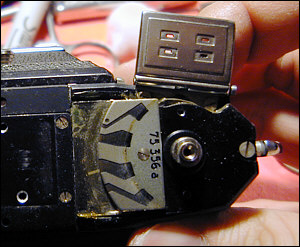 |
Final note: With the meter completely blocked from light, the
needle should line up with the black dot, which you can see above. If
it's not lining up, turn the small calibration screw on the back of the camera. |
|